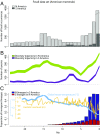Biological evidence supports an early and complex emergence of the Isthmus of Panama
- PMID: 25918375
- PMCID: PMC4434730
- DOI: 10.1073/pnas.1423853112
Biological evidence supports an early and complex emergence of the Isthmus of Panama
Erratum in
-
Correction for Bacon et al., Biological evidence supports an early and complex emergence of the Isthmus of Panama.Proc Natl Acad Sci U S A. 2015 Jun 16;112(24):E3153. doi: 10.1073/pnas.1509107112. Epub 2015 May 22. Proc Natl Acad Sci U S A. 2015. PMID: 26002921 Free PMC article. No abstract available.
-
Correction to Supporting Information for Bacon et al., Biological evidence supports an early and complex emergence of the Isthmus of Panama.Proc Natl Acad Sci U S A. 2015 Jul 7;112(27):E3631. doi: 10.1073/pnas.1511204112. Epub 2015 Jun 18. Proc Natl Acad Sci U S A. 2015. PMID: 26089437 Free PMC article. No abstract available.
Abstract
The linking of North and South America by the Isthmus of Panama had major impacts on global climate, oceanic and atmospheric currents, and biodiversity, yet the timing of this critical event remains contentious. The Isthmus is traditionally understood to have fully closed by ca. 3.5 million years ago (Ma), and this date has been used as a benchmark for oceanographic, climatic, and evolutionary research, but recent evidence suggests a more complex geological formation. Here, we analyze both molecular and fossil data to evaluate the tempo of biotic exchange across the Americas in light of geological evidence. We demonstrate significant waves of dispersal of terrestrial organisms at approximately ca. 20 and 6 Ma and corresponding events separating marine organisms in the Atlantic and Pacific oceans at ca. 23 and 7 Ma. The direction of dispersal and their rates were symmetrical until the last ca. 6 Ma, when northern migration of South American lineages increased significantly. Variability among taxa in their timing of dispersal or vicariance across the Isthmus is not explained by the ecological factors tested in these analyses, including biome type, dispersal ability, and elevation preference. Migration was therefore not generally regulated by intrinsic traits but more likely reflects the presence of emergent terrain several millions of years earlier than commonly assumed. These results indicate that the dramatic biotic turnover associated with the Great American Biotic Interchange was a long and complex process that began as early as the Oligocene-Miocene transition.
Keywords: biogeography; evolution; fossil; migration; neotropics.
Conflict of interest statement
The authors declare no conflict of interest.
Figures


Comment in
-
Reply to Lessios and Marko et al.: Early and progressive migration across the Isthmus of Panama is robust to missing data and biases.Proc Natl Acad Sci U S A. 2015 Oct 27;112(43):E5767-8. doi: 10.1073/pnas.1515451112. Epub 2015 Oct 21. Proc Natl Acad Sci U S A. 2015. PMID: 26489656 Free PMC article. No abstract available.
-
Do large molecular sequence divergences imply an early closure of the Isthmus of Panama?Proc Natl Acad Sci U S A. 2015 Oct 27;112(43):E5766. doi: 10.1073/pnas.1515048112. Epub 2015 Oct 21. Proc Natl Acad Sci U S A. 2015. PMID: 26489657 Free PMC article. No abstract available.
-
Appearance of an early closure of the Isthmus of Panama is the product of biased inclusion of data in the metaanalysis.Proc Natl Acad Sci U S A. 2015 Oct 27;112(43):E5765. doi: 10.1073/pnas.1514719112. Epub 2015 Oct 21. Proc Natl Acad Sci U S A. 2015. PMID: 26489658 Free PMC article. No abstract available.
References
-
- Simpson GG. Splendid Isolation: The Curious History of South American Mammals. Yale Univ Press; New Haven, CT: 1980.
-
- Stehli FG, Webb SD. The Great American Biotic Interchange. Plenum Press; New York: 1985.
-
- Wallace AR. The Geographical Distribution of Animals. With a Study of the Relations of Living and Extinct Faunas as Eludicidating the Past Changes of the Earth’s Surface. Macmillan and Co.; London: 1876.
-
- Webb SD. Ecogeography and the Great American Interchange. Paleobiology. 1991;17(3):226–280.
-
- Webb SD, Rancy A. Late Cenozoic evolution of the neotropical mammal fauna. In: Jackson JBS, Budd AF, Coates AG, editors. Evolution and Environment in Tropical America. University of Chicago Press; Chicago: 1996. pp. 335–358.
Publication types
MeSH terms
LinkOut - more resources
Full Text Sources
Other Literature Sources

